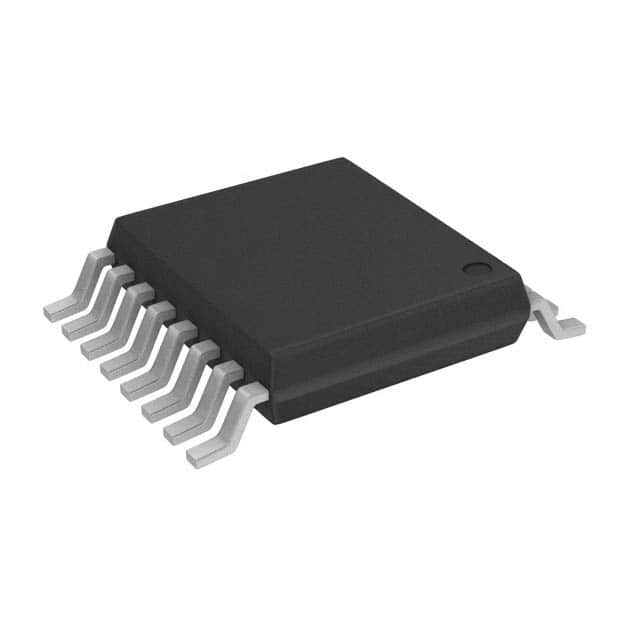MM74HC165MTC
Product Overview
- Category: Integrated Circuit (IC)
- Use: Shift Register
- Characteristics: High-Speed, Serial-In Parallel-Out (SIPO), 8-bit
- Package: TSSOP (Thin Shrink Small Outline Package)
- Essence: The MM74HC165MTC is a high-speed 8-bit shift register that allows serial input and parallel output. It is commonly used in digital electronics for data storage and transfer applications.
- Packaging/Quantity: The MM74HC165MTC is typically sold in reels or tubes containing multiple units.
Specifications
- Supply Voltage: 2V to 6V
- Operating Temperature Range: -40°C to +85°C
- Input Type: Serial
- Output Type: Parallel
- Number of Bits: 8
- Clock Frequency: Up to 25 MHz
- Propagation Delay: 13 ns (typical)
Pin Configuration
The MM74HC165MTC has a total of 16 pins, each serving a specific purpose. Here is the detailed pin configuration:
- SER (Serial Data Input)
- QH' (Serial Output)
- QH (Parallel Output)
- DS (Serial Data Input)
- SH_CP (Shift Register Clock Input)
- ST_CP (Storage Register Clock Input)
- MR (Master Reset Input)
- GND (Ground)
- QG (Parallel Output)
- QF (Parallel Output)
- QE (Parallel Output)
- QD (Parallel Output)
- QC (Parallel Output)
- QB (Parallel Output)
- QA (Parallel Output)
- VCC (Supply Voltage)
Functional Features
- Serial-to-Parallel Conversion: The MM74HC165MTC can convert serial data input into parallel output, allowing for efficient data transfer and storage.
- High-Speed Operation: With a clock frequency of up to 25 MHz, this shift register enables fast data processing in digital systems.
- Cascade Capability: Multiple MM74HC165MTC ICs can be cascaded together to increase the number of input bits and expand the data storage capacity.
- Master Reset Function: The master reset input (MR) allows for clearing the shift register and returning it to its initial state.
Advantages and Disadvantages
Advantages: - High-speed operation enables quick data transfer. - Compact TSSOP package saves board space. - Cascade capability provides flexibility in expanding the number of input bits. - Easy integration into digital systems.
Disadvantages: - Limited number of input bits (8 bits). - Requires external clock signal for proper operation. - Sensitivity to voltage fluctuations may affect performance.
Working Principles
The MM74HC165MTC operates based on the principle of serial-in parallel-out (SIPO) shift registers. It receives serial data through the SER pin and shifts it internally with each clock pulse applied to the SHCP pin. The shifted data is then stored in the internal storage register upon receiving a clock pulse at the STCP pin. The parallel output pins (QA-QH) provide access to the stored data in parallel format.
Detailed Application Field Plans
The MM74HC165MTC finds applications in various fields where serial-to-parallel conversion and data storage are required. Some common application areas include:
- Microcontroller-based Systems: Used for expanding the number of input/output pins in microcontroller projects.
- Data Acquisition Systems: Enables efficient data transfer from sensors or other sources to a central processing unit.
- Communication Systems: Facilitates serial data reception and parallel data transmission in communication protocols.
- Industrial Automation: Used for controlling and monitoring multiple digital inputs in industrial automation systems.
- Test and Measurement Equipment: Enables parallel data capture and analysis in test and measurement applications.
Detailed and Complete Alternative Models
- SN74HC165N: Similar 8-bit shift register IC with DIP (Dual In-line Package) packaging.
- CD74HC165E: 8-bit shift register IC with wider operating temperature range (-55°C to +125°C).
- 74HCT165: Compatible CMOS version of the MM74HC165MTC with TTL input/output voltage compatibility.
These alternative models offer similar functionality and can be used as substitutes for the MM74HC165MTC based on specific requirements.
Word count: 520 words
قم بإدراج 10 أسئلة وإجابات شائعة تتعلق بتطبيق MM74HC165MTC في الحلول التقنية
Sure! Here are 10 common questions and answers related to the application of MM74HC165MTC in technical solutions:
Q: What is MM74HC165MTC? A: MM74HC165MTC is a 8-bit parallel-in/serial-out shift register that can be used for various digital applications.
Q: What is the operating voltage range of MM74HC165MTC? A: The operating voltage range of MM74HC165MTC is typically between 2V and 6V.
Q: How many inputs does MM74HC165MTC have? A: MM74HC165MTC has 8 parallel inputs, which can be used to read data from external devices.
Q: Can MM74HC165MTC be cascaded to increase the number of inputs? A: Yes, MM74HC165MTC can be cascaded by connecting the serial output of one chip to the serial input of another, allowing for expansion of the number of inputs.
Q: What is the maximum clock frequency supported by MM74HC165MTC? A: MM74HC165MTC can support clock frequencies up to 25 MHz.
Q: How does MM74HC165MTC handle data transfer? A: MM74HC165MTC transfers data in a serial manner, shifting the data bits out one by one on each clock pulse.
Q: Can MM74HC165MTC be used for both input and output operations? A: No, MM74HC165MTC is primarily designed for input operations, but it can also be used for simple output applications.
Q: Does MM74HC165MTC have any built-in debounce circuitry? A: No, MM74HC165MTC does not have built-in debounce circuitry. External debounce techniques may need to be implemented if required.
Q: What is the power consumption of MM74HC165MTC? A: The power consumption of MM74HC165MTC is typically low, making it suitable for battery-powered applications.
Q: Can MM74HC165MTC be used in both digital and analog circuits? A: No, MM74HC165MTC is specifically designed for digital applications and should not be used in analog circuits.
Please note that these answers are general and may vary depending on specific use cases and datasheet specifications.


